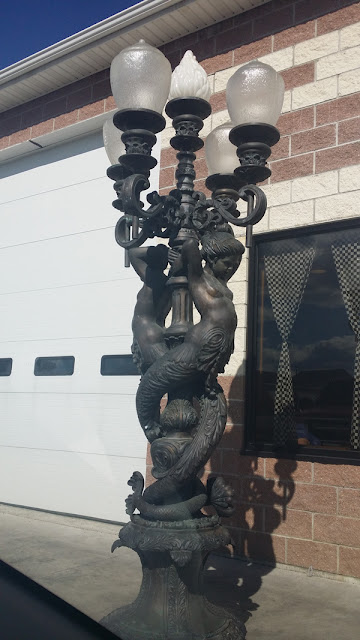On the long, painful flight to Narita from Dulles, I went without in-flight entertainment for as long as I could, making it about eleven hours before I finally flipped on the tiny back-of-the-seat monitor and called up "Ant-Man," one of the most recent, and most lightweight, entries in the overcrowded Marvel universe. "Ant-Man" stars three actors I like: Paul Rudd, Michael Douglas, and Evangeline Lilly.
Rudd plays Scott Lang, a kind-hearted master burglar who loves his little daughter Cassie (winsome Abby Ryder Fortson), but who is restricted from seeing her because he is divorced and behind on child-support payments. After an opening sequence that shows Hank Pym (Michael Douglas, de-aged through CGI) angrily quitting SHIELD in 1989, the main story begins with Lang leaving a stint at the penitentiary. He gets in the van with former cellmate Luis (Michael Peña, our resident comic relief), who immediately invites Lang in on a potentially huge score. Lang refuses, unwilling to risk prison again, but desperation soon makes him interested in Luis's proposed heist. The burglary involves breaking into a mansion to steal something—we don't know what, and neither do the thieves—that has high cash value. Lang succeeds at breaking into the house... only to discover that the item in question is some sort of 1950s-era "motorcycle suit." Curious all the same, Lang takes the suit home, puts it on, then somehow activates it. To his initial horror, the suit shrinks him to the size of an ant, and the story kicks into high gear.
It turns out that the suit belongs to the aforementioned Hank Pym, discoverer of the "Pym Particle," a subatomic unit that allows "the space between atoms" (don't ask—the science in this film is utter nonsense) to be radically reduced. Pym has a daughter, Hope (Evangeline Lilly), with whom he has been estranged since the apparent death of Hank's wife, Hope's mother. Hope works for Hank's former student and current intellectual rival, Darren Cross (Corey Stoll), who has long suspected the existence of Hank's shrinkage technology, and who is building his nasty, armed equivalent of the Ant-Man suit: the Yellowjacket. If action movies are driven by a ticking clock, then the clock, in this case, is Cross's eventual finalization of the Yellowjacket suit, which Cross then means to manufacture in droves to create a new type of high-tech army. Can Scott Lang master the Ant-Man suit to help Hank Pym avert the world's destruction? Can Hank reconcile with his daughter? Will Darren Cross succeed in creating the Yellowjacket? Have you ever watched a Marvel movie before?
I found "Ant-Man" to be light entertainment at best. It wasn't bad, but it had the same sort of major Hollywood-physics problems that plague the Thor movies, among others. There were plot points that I enjoyed: Scott's touching relationship with his daughter, who loves him despite the terrible things she hears about him; Scott's evolving relationship with Hope; Hope's tense exchanges with her father; Luis's bizarre cheer and optimism in the face of deadly adversity. I just wish I could get past the quantum nonsense and the biological implausibilities that the "science" of "Ant-Man" poses.
For example: Hope tells Scott that, even when he shrinks to the size of an ant, he will still have the punching power of a 200-pound man. This gives the filmmakers a chance to put together some hilariously comical fight scenes as Scott shrinks and reenlarges from moment to moment during hand-to-hand combat. But it makes one wonder how it is that, although Scott retains his full-size punching power, he has managed to lose most of his mass. F = ma is one of the most basic formulae that you learn in physics: if Scott loses his mass, then he loses his punching force; if he's retained his punching force, he must also have retained his mass. Something's gotta give.*
Later in the movie, Scott finds himself shrunken down to the quantum realm (the fate that befell Hank Pym's wife; she never returned), which the filmmakers portray as a phantasmagoric light show. Earlier in the film—and in a manner somewhat consistent with actual quantum physics—Hank Pym had warned Scott that the quantum realm was a place in which concepts like time, cause, and effect had no anthropic-level meaning... and yet we see Scott doing things, at the quantum level, that are consistent with anthropic-level physics: when Scott moves, there's time, cause, and effect.
Along with the wacky physics, there's the wacky biology. Ants are made to seem the equivalent of dogs, albeit dogs that are socially linked into colonies, not packs. Scott Lang even "befriends" one flying ant, and later in the film, an ant gets enlarged by one of Dr. Pym's weird weapons, and it becomes a family pet that Cassie feeds under the table. Ants breathe through spiracles (read more about them here), a biological structure that works just fine for God's tinier creatures, but when you blow an ant up to the size of a German shepherd, there's simply no way the ant can continue to breathe (unless, I suppose, it has retained its ant-sized mass... in which case it's going to blow away like a balloon, given its low density). So yeah, the movie's notions of biology are just as silly as its notions of physics.
True: the other Marvel films showcase their own ridiculous implausibilities, but for whatever reason, the Hollywood physics in "Ant-Man," perhaps because it's meant to be so front-and-center, was a true turn-off for me. I couldn't enjoy the movie as much as I'd wanted to. That said, I give full marks for good intentions. All the actors are likable; the story is serviceable and consistent with the rest of the Marvel universe; the comedy makes up for many of the movie's deficiencies. My recommendation: view at your own risk. You won't hate "Ant-Man," but you probably won't love it, either.
*Related to this is a problem that's actually mentioned in the movie: if Scott can, while shrunken, still punch with the force of a full-sized man, his fist now has such a tiny surface area that the impact of his blow would be more like the impact of a bullet or a needle. (Hope says "bullet," even though "needle" would be closer to the reality.) The fights should therefore have been a lot bloodier: far from punching his opponents, a shrunken Scott would have been stinging them or, at the very least, violently puncturing them. That's not what we see, though: during the fights in "Ant-Man," we see opponents reeling from blows that seem to have been delivered by an invisible boxer.
The film's not even consistent with its own notion of physics.
_










































